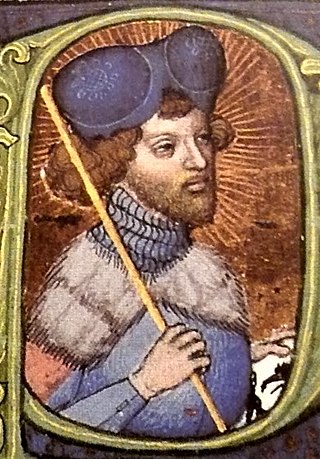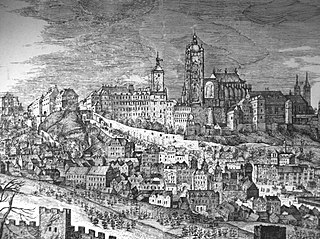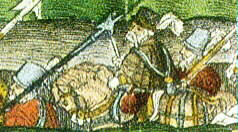
Wenceslaus IV, also known as Wenceslaus of Luxembourg, was King of Bohemia from 1378 until his death and King of Germany from 1376 until he was deposed in 1400. As he belonged to the House of Luxembourg, he was also Duke of Luxembourg from 1383 to 1388.

Charles IV, also known as Charles of Luxembourg, born Wenceslaus, was the first King of Bohemia to become Holy Roman Emperor. He was a member of the House of Luxembourg from his father's side and the Bohemian House of Přemyslid from his mother's side; he emphasized the latter due to his lifelong affinity for the Bohemian side of his inheritance, and also because his direct ancestors in the Přemyslid line included two saints.
The Vogtlandkreis is a Landkreis in the southwest of Saxony, Germany, at the borders to Thuringia, Bavaria, and the Czech Republic. Neighboring districts are Hof, Saale-Orla, Greiz, Zwickau and Erzgebirgskreis.

Auerbach is a town in the Vogtlandkreis, Saxony, Germany. It is the regional centre of the eastern Vogtland. The economy is mainly based on textile manufacturing, food processing and machine industry. After Plauen and Reichenbach, Auerbach is the third most populous town in the Vogtlandkreis.

Reichenbach im Vogtland is a town in the Vogtlandkreis district of Saxony in eastern Germany. With a population of 20,108, it is the second-largest town in the Vogtlandkreis after Plauen. It is located close to the A72 between Plauen and Zwickau.

Vogtland is a region spanning the German states of Bavaria, Saxony and Thuringia and north-western Bohemia in the Czech Republic. It overlaps with and is largely contained within Euregio Egrensis. The name alludes to the former leadership by the Vögte of Weida, Gera and Plauen.

Karlštejn Castle is a castle in the Czech Republic. It is a large Gothic castle founded in 1348 by King Charles IV. The castle served as a place for safekeeping the Imperial Regalia as well as the Bohemian Crown Jewels, holy relics, and other royal treasures. Karlštejn belongs to the most famous and most frequently visited castles in the country.

Nuremberg Castle is a group of medieval fortified buildings on a sandstone ridge dominating the historical center of Nuremberg in Bavaria, Germany.

The Kingdom of Bohemia, sometimes in English literature referred to as the Czech Kingdom, was a medieval and early modern monarchy in Central Europe, the predecessor of the modern Czech Republic. It was an Imperial State in the Holy Roman Empire, and the Bohemian king was a prince-elector of the empire. The kings of Bohemia, besides the region of Bohemia proper itself, also ruled other lands belonging to the Bohemian Crown, which at various times included Moravia, Silesia, Lusatia, and parts of Saxony, Brandenburg, and Bavaria.

The history of Prague covers more than a thousand years, during which time the city grew from the Vyšehrad Castle to the capital of a modern European state, the Czech Republic.
Mylau is a town and a former municipality in the Vogtlandkreis district, in the Free State of Saxony, Germany with about 2600 citizens. Since 1 January 2016 it is part of the town Reichenbach im Vogtland. It is situated in the valleys of the river Göltzsch and the Raumbach, a stream flowing from Reichenbach im Vogtland that is locally known as the Soap Stream because of the textile painting factories that had been built by its banks. The town lies 6 km southeast of Greiz, and 20 km southwest of Zwickau. Mylau has the smallest area of any town ("Stadt") in what was formerly East Germany, although there are 10 towns in what was formerly West Germany that are even smaller in area.
Vogtlandian is an East Franconian dialect, spoken in Vogtland.

Reichenbach (Vogtland) Oberer Bahnhof(Upper station) is the main railway station of Reichenbach im Vogtland in the German state of Saxony. It is the only remaining station in Reichenbach, which once had three stations, and is located on the Saxon-Franconian trunk line between Nuremberg and Dresden. It is also the last major station before the junction with the main line to Leipzig from the direction of Nuremberg and Plauen. Together with Plauen station, it used to be one of two DB Fernverkehr stations in Vogtland.

The Treaty of Eger, also called Main Compromise of Eger or Peace of Eger was concluded on 25 April 1459 in the Imperial City of Eger (Cheb), administrative seat of the immediate pawn of Egerland. The treaty established the border between the Kingdom of Bohemia and the Electorate of Saxony on the main ridge of the Ore Mountains stretching from Eger to the River Elbe. The border remains largely unchanged up to today, separating the Czech Republic and Germany, and is thus one of the oldest still extant borders in Europe.

The Göltzsch Viaduct is a railway bridge in Germany. It is the largest brick-built bridge in the world, and for a time it was the tallest railway bridge in the world. It spans the valley of the Göltzsch River between the Reichenbach im Vogtland district of Mylau and the adjacent town of Netzschkau in the German Free State of Saxony.
Henry V of Plauen was Burgrave of Meissen and Lord of Plauen and Voigtsberg.

Henry IV of Plauen, was High Chancellor of the Kingdom of Bohemia, Burgrave of Meissen, Lord of Plauen, Gera, Greiz, Schleiz and Bad Lobenstein, Lord of Toužim, Hartenštejn Castle, Andělská Hora Castle and Žlutice. He also used the traditional title of Lord of Lázně Kynžvart and, apart from an intermezzo in 1547, he was Lord of Bečov nad Teplou as well.

Mildenstein Castle, in German Burg Mildenstein, also called Schloss Leisnig, is located in Leisnig in Landkreis Mittelsachsen, Saxony, Germany. It is a property of the Free State of Saxony and is administrated by the company State Palaces, Castles and Gardens of Saxony.
The imperial election of October 1, 1410 was an imperial election held to select the emperor of the Holy Roman Empire.
The imperial election of 1411 was an imperial election held to select the emperor of the Holy Roman Empire. It took place on July 21.

















